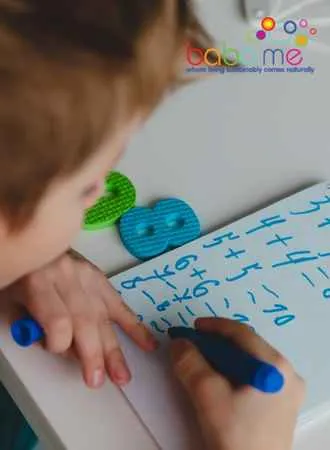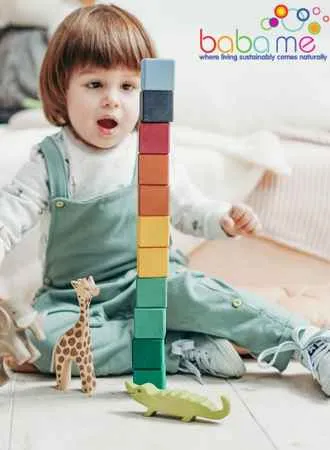In a world where technology rapidly shapes our daily life, it’s crucial to prepare our children for a future driven by innovation. This is where STEM (Science, Technology, Engineering, and Math) toys come into play. These aren’t just ordinary playthings; they are tools of discovery, creativity, and problem-solving.
From building complex structures to experimenting with simple machines, STEM toys offer an engaging way for kids to explore scientific concepts, fostering a love for learning and an understanding of the world around them.
Dive into this blog to explore the compelling reasons why your child needs STEM toys in their playroom.
STEM toys are designed to foster curiosity and critical thinking in Science, Technology, Engineering, and Math. These interactive toys stimulate problem-solving, logical reasoning, and creativity, forming a solid foundation for these essential skills. Not only do they make learning fun, but STEM toys also prepare children for a technology-driven future, nurturing innovative thinkers and potential leaders.
What are Stem Toys?
For those of you who may not be familiar, stem toys are toys that are designed to help kids learn about science, technology, engineering, and math. These toys usually come with lots of different pieces and parts, and kids can use them to build all sorts of different things.
Stem Toys can be as simple as blocks or puzzles to more complex robotics.

The goal of stem toys is to give a child an interactive way of learning and exploring the world around them.
The benefits of stem toys for kids:
- Hands-on, interactive learning
- Development of important skills like problem-solving and critical thinking
- Exposure to important subjects like science, technology, engineering, and math
- Encouragement of creativity and imagination
Now, you might be wondering why stem toys are so important for child development. Well, there are actually a lot of benefits to incorporating stem toys and stem subjects into your child’s play routine.
Stem toys are hands-on and interactive. This means that kids can actively engage with the material and learn stem skills in a meaningful way, rather than just passively reading about it or watching a video. This kind of active learning can be much more effective at helping kids engage retain information and develop important skills.
Stem concepts can help kids develop a wide range of important skills, including problem-solving, critical thinking, creativity, and spatial reasoning. These are all skills that are valuable not only in school, but in many different careers and fields of study.
By playing with stem toys from an early age, kids can learn how to think for themselves and find solutions to complex problems.
Stem education is about teaching kids about subjects like science, technology, engineering, and math. Stem learning kids can develop a strong foundation in these subjects along with logical reasononing and lay the groundwork for future success.
Stem subjects encourage logical reasoning, creative thinking and engineering concepts
Why are STEM toys important for kids?
STEM toys are important for kids for a number of reasons. First of all, STEM toys are designed to be hands-on and interactive, which means that kids can actively engage with the material in a meaningful way.
This kind of active learning can be much more effective at helping kids retain information and develop important skills.
STEM toys can help kids develop a wide range of important skills, including problem-solving, critical thinking, creativity, and spatial reasoning. These are all skills that are valuable not only in school, but in many different careers and fields of study.
By playing with STEM toys, kids can learn how to think for themselves and find solutions to complex problems.
STEM toys can help kids learn about important subjects like science, technology, engineering, and math. These subjects are not only interesting and important in their own right, but they are also key to many different careers and fields of study.

Types of STEM toys
STEM toys are educational toys that are designed to teach children about science, technology, engineering, and math. These toys can come in a variety of forms, including building sets and construction toys, building blocks, robotics sets, coding toys and chemistry kits.
Some examples of STEM toys include Legos, K’Nex, and Osmo. These toys can help children develop important skills such as problem-solving, critical thinking, and creativity.
STEM toys can be a fun and engaging way for children to learn about these subjects and lay the foundation for a future career in a STEM field.
Buying Guide for Stem Toys for your Child:
So, now that you know the benefits of stem toys, you might be wondering how to choose the right ones for your child. Here are a few tips to keep in mind:
- Make sure the stem toy is developmentally appropriate for your child’s age and abilities. There are stem toys available for kids of all ages, from young kids to teenagers, so it’s important to choose one that is appropriate for your child’s specific needs.
- Look for stem toys that encourage hands-on, interactive play. As we discussed earlier, this kind of play is key to helping kids learn and develop important skills.
- Consider your child’s interests and passions. If your child is passionate about a particular subject, like robotics or chemistry, look for stem toys that align with those interests. This will help make the learning process more engaging and enjoyable for your child.
- Don’t be afraid to try out different stem toys and see what works best for your child. Every child is different, so what works for one child may not work for another. Experiment and see what your child enjoys and finds most engaging.

SUMMARY
Stem toys and stem education are a valuable tool for helping kids learn and grow in a fun and engaging way. They are educational toys that offer a host of benefits, including hands-on, interactive learning, the development of important skills, and exposure to important subjects.
If you’re looking for a way to enhance your child’s learning experience, consider incorporating cognitive skills STEM toys into their play routine.
FAQs on Stem Toys
What Is Stem Toy?
STEM toys are educational toys that are designed to teach children using hands on learning about science, technology, engineering, and math.
Do stem toys helps with fine motor skills?
Yes, stem toys can help with fine motor skills. Because stem toys often require kids to manipulate small pieces and parts, they can help develop and strengthen the muscles in their hands and fingers. This, in turn, can improve their fine motor skills, which are important for tasks like writing, drawing, and tying shoelaces.
For example, a stem toy that involves building with small blocks or puzzle pieces can help kids develop their fine motor skills. These toys require kids to grasp, twist, and manipulate the pieces, which can help strengthen the muscles in their hands and fingers.

What is the difference between STEM toys and STEAM toys?
The main difference between STEM toys and STEAM toys is the addition of the “A” in STEAM. STEM stands for science, technology, engineering, and math, while STEAM adds art to the mix. So, while STEM toys focus on the subjects of science, technology, engineering, and math, STEAM toys also incorporate elements of art and creativity.
Do STEM toys work?
Yes, STEM toys can work to help kids learn and develop important skills. Because STEM toys are hands-on and interactive, they can encourage kids to engage with the material in a meaningful way. This kind of active learning can be much more effective than simply reading about a concept or watching a video about it.

Are Legos a stem toy?
Yes, Legos can be considered a stem toy. Legos are a popular building toy that consists of interlocking plastic bricks that kids can use to construct all sorts of different structures. Because Legos involve building, problem-solving, and spatial reasoning, they can be considered a STEM toy.
In fact, many parents and educators use Legos as a way to help kids learn about science, technology, engineering, and math in a fun and engaging way. For instance, kids can use Legos to build simple machines, like cars or boats, and learn about the principles of engineering. They can also use Legos to create structures and buildings, and learn about geometry and spatial reasoning.





